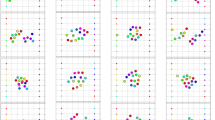Abstract
A fuzzy logic resource allocation algorithm that enables a collection of unmanned aerial vehicles (UAVs) to automatically cooperate will be discussed. The goal of the UAVs’ coordinated effort is to measure the atmospheric index of refraction. Once in flight no human intervention is required. A fuzzy logic based planning algorithm determines the optimal trajectory and points each UAV will sample, while taking into account the UAVs’ risk, risk tolerance, reliability, and mission priority for sampling in certain regions. It also considers fuel limitations, mission cost, and related uncertainties. The real-time fuzzy control algorithm running on each UAV renders the UAVs autonomous allowing them to change course immediately without consulting with any commander, requests other UAVs to help, and change the points that will be sampled when observing interesting phenomena. Simulations show the ability of the control algorithm to allow UAVs to effectively cooperate to increase the UAV team’s likelihood of success.
Access this chapter
Tax calculation will be finalised at checkout
Purchases are for personal use only
Preview
Unable to display preview. Download preview PDF.
Similar content being viewed by others
References
Blake, L. V. 1986. Radar Range-Performance Analysis, Boston, Artech House.
Blackman, S. and Popoli, R. 1999. Design and Analysis of Modern Tracking Systems, Boston, Artech House, Chapter 11.
Russel, S. J. and Norvig, P. 2002. Artificial Intelligence: A Modern Approach (2nd Edition), Englewood Cliffs, Prentice-Hall.
Smith, J. F., 2002a. Co-evolutionary Data Mining to Discover Rules for Fuzzy Resource Management, In: H. Yin, ed., Proceedings of the International Conference for Intelligent Data Engineering and Automated Learning, August, Manchester, Springer-Verlag, 19–24.
Smith, J. F., 2002b. Data Mining for Fuzzy Decision Tree Structure with a Genetic Program, In:H. Yin, ed., Proceedings of the International Conference for Intelligent Data Engineering and Automated Learning, August, Manchester, Springer-Verlag, 13–18.
Smith, J. F., 2003. Fuzzy logic resource manager: decision tree topology, combined admissible regions and the self-morphing property, In:I. Kadar ed., Signal Processing, Sensor Fusion, and Target Recognition XII, Vol. 5096, April, Orlando, SPIE Proceedings, 104–114.
Smith, J. F., 2004a. Fuzzy logic resource manager: real-time adaptation and self organization, In:I. Kadar, ed.,Signal Processing, Sensor Fusion, and Target Recognition XIII, Vol. 5429, April, Orlando, SPIE Proceedings, 77–88.
Smith, J. F., 2004b. Genetic Program Based Data Mining for Fuzzy Decision Trees, In: H. Yin, ed., Proceedings of the International Conference for Intelligent Data Engineering and Automated Learning, August, Exeter, Springer-Verlag, 464–470.
Smith, J. F., Nguyen, and T. H., 2005. Distributed autonomous systems: resource management, planning, and control algorithms, In: I. Kadar, ed., Signal Processing, Sensor Fusion, and Target Recognition XIV, Vol. 5809, April, Orlando, SPIE Proceedings, 65–76.
Spears, D. and Zarzhitsky, D., 2005. Multi-robot chemical plume tracing, In: A. Schultz, ed. Multi-Robot Systems: From Swarms to Intelligent Automata, Vol. III, May, New York, Springer, 211–221.
Tsoukalas, L. H. and Uhrig, R. E. 1997. Fuzzy and Neural Approaches in Engineering, New York, John Wiley and Sons, Chapter 5.
Author information
Authors and Affiliations
Editor information
Editors and Affiliations
Rights and permissions
Copyright information
© 2008 Springer-Verlag Berlin Heidelberg
About this chapter
Cite this chapter
Smith III, J.F., Nguyen, T.H. (2008). Fuzzy Logic Based UAV Allocation and Coordination. In: Cetto, J.A., Ferrier, JL., Costa dias Pereira, J., Filipe, J. (eds) Informatics in Control Automation and Robotics. Lecture Notes Electrical Engineering, vol 15. Springer, Berlin, Heidelberg. https://doi.org/10.1007/978-3-540-79142-3_8
Download citation
DOI: https://doi.org/10.1007/978-3-540-79142-3_8
Publisher Name: Springer, Berlin, Heidelberg
Print ISBN: 978-3-540-79141-6
Online ISBN: 978-3-540-79142-3
eBook Packages: EngineeringEngineering (R0)




